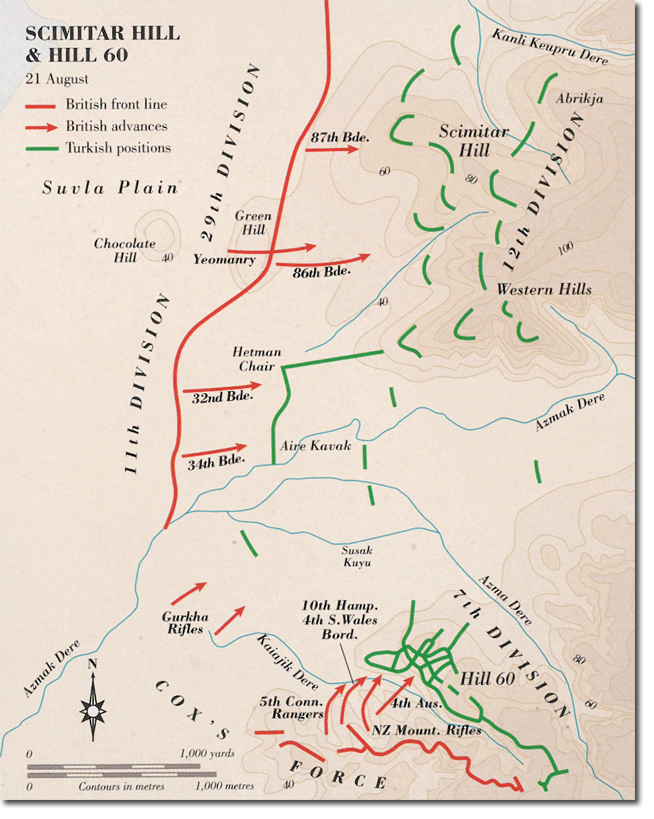|
|


|
| The aim for the offensive on 21 August wa for the
29th Division to advance from Chocolate Hill to Scimitar
Hill. The 11th Division was to take Western Hills. Meanwhile
a composite brigad from Anzac was to take Hill 60. The
Yeomanry of the 2nd Mounted Division were held in
reserve in a dismounted role. The attack would start at 3 p.m. The preceding bombardment by 85 assorted guns
the battleship Swiftsure, three cruisers and two destroyers,
and which was a mere half-hour because of lack of ammunition,
was rendered almost ineffective by haze which obscured
the spotters and the Turks were barely touched.
The 11th Division went over the top to be mown down by Turkish fire. By 5 p.m. their attack had failed. The 29th Division came under heavy shell-fire before they had even left their trenches . The scrub caught fire and smoke and dust hung thickly over the battlefield, while Turkish machine- guns firing through the murk on fixed lines, cut down the attackers. The approaches to Scimitar Hill were carpeted with dead and dying British soldiers. Some of 1st Royal Innikillings and the Borders reached the summit, but most were killed or wounded and the attack failed. It was now the turn of the Yeomanry of 2nd Mounted Division to attack under a sky turned dark by cloud of smoke and dust. They advanced from behind Chocolate Hill with no clear orders. The Commanding Officer of the Sherwood Rangers Yeomanry told his officers, "we are to take a redoubt. But I don t know where it is and don't think anyone else does either. But in any case we are to go ahead and attack any Turks we meet." He and the other commander led their men into oblivion. Of 14,300 men from the three divisions, 5,300 were killed, wounded or missing. The dead from the Yeomanry included Brigadier General Lord Longford , Brigadier General Kenna VC a d Colonel Sir John Milbanke VC at the head of their soldiers. They and their men had been sacrificed for nothing. Hill 60, defended by a maze of Turkish trenches, was to be attacked by a composite force under Brigadier General Herbert Vaughan Cox consisting of his own 29th Indian Brigade, the 4th Australian Brigade, two regiments of New Zealand Mounted Rifles, the 5th Connaught Rangers the 10th Hampshire and he 4th South Wales Borderers; all of them with the exception of the Connaught Rangers were seriously depleted. Again the preliminary bombardment lasted a mere 30 minutes.The attackers were hard hit the minute they left their trenches.The scrub caught fire and wounded men were burnt to death or killed by their exploding ammunition pouches. The fighting raged all night, and for a week afterwards. For the rest of the campaign the summit was shared by both sides; but the attack had completely exhausted the Anzac soldiers. It is best summed up by the official history: "The bitter fighting on Hill 60, still regarded by the Australians and New Zealanders as perhaps their sternest trial in Gallipoli, had added the last straw ... the men had only been able to carry on by sheer force of will. Their spirit, indeed, was so splendid that the higher commanders, judging from appearances, believed them capable of greater efforts than were humanly possible. Courage, morale, and the excitement of the moment enabled them to fight in flashes; but the prolonged strain at Anzac - the fighting, the heat, and the constant debilitating sickness - had made too prodigal a call upon their store of nervous energy, and at the end of August the Anzac Corps was temporarily incapable of further offensive effort." |
Armed Forces | Art and Culture | Articles | Biographies | Colonies | Discussion | Glossary | Home | Library | Links | Map Room | Sources and Media | Science and Technology | Search | Student Zone | Timelines | TV & Film | Wargames